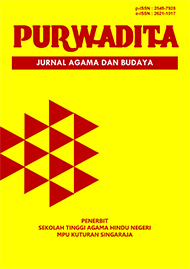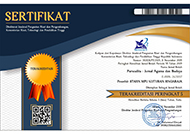Analisis Pemberian Moko Sebagai Belis Dalam Perkawinan Adat Pada Masyarakat Alor
Sari
Kata Kunci
Teks Lengkap:
PDFReferensi
Abdullah, I. (2010). Konstruksi dan Reproduksi Kebudayaan. Yogyakarta: Pustaka Pelajar
Aksan, N. et al (2009). Symbolic interaction theory. Procedia Social and Behavioral Sciences 1 902–904. Elsevier Ltd.
Alfilda, R & Saiful, U (2016) Penempatan Mahar Bagi Perempuan di Desa Kampung Paya Kecamatan Kluet Utara, Kabupaten Aceh Selatan dalam Jurnal Ilmiah Mahasiswa Pendidikan Kewarganegaraan. Vol. 1, No 1, Agustus 2016, hlm, 89-96
Annisa Ulya, (2018) Usia edial perkawinan persfektif kompilasi Hukum Islam, Lampung, Universitas Islam Negeri Raden Intan Lampung, 34
Arndt, P. (2009). Masyarakat ngadha: keluarga, tatanan sosial, pekerjaan dan hukum adat. Ende: Nusa Indah.
Dafiq, N. (2018). Dinamika psikologis pada masyarakat Manggarai terkait budaya belis. Wawasan Kesehatan. https://stikessantupaulus.e journal.id/JWK/article/view/48
Deke, M. E., Bahari, Y., & Salim, I. (2020). Perubahan Wujud dan Makna Belis Dalam Perkawinan Adat Bajawa Boba. Jurnal Pendidikan dan Pembelajaran Khatulistiwa,9(7).https://jurnal.untan.ac.id/index.
php/jpdpb/article/view/41411
Engo, C. B. (2018). Budaya nage: perjalanan hidup orang nage di nagekeo. Ende: Nusa Indah.
Fajriyah, E. (2018). Peran etnomatematika terkait konsep matematika dalam mendukung literasi. PRISMA: Prosiding Seminar Nasional Matematika, 1, 114–119.
Fransisika, I. N. dan Novi, T.H. (2018). “Belis: Tradisi Perkawinan Masyarakat Insana Kabupaten Timur Tengah Utara (Kajian Historis dan Budaya Tahun 2000-2017)”. Jurnal Agastya. Program Studi Pendidikan Sejarah FKIP Universitas PGRI Madiun, 08, (01), 107-126
Juliawati, (2016). Moko sebagai mas kawin (belis) pada perkawinan adat masyarakat Alor. In Forum Arkeologi (Vol. 26, No. 3).
Juliawati, P. E. (2013). Moko sebagai mas kawin (belis) pada perkawinan adat masyarakat alor. Forum Arkeologi. Balai Arkeologi Denpasar (26), 3 , 195 - 206
Jeli, O. S., & Purawati, N. K. (2019). Sistem Perkawinan Adat Manggarai Dalam Perspektif Gender , Desa Nggalak Kecamatan Reok Barat Kabupaten Manggarai Tengah. 07(1).
Kurnia, Heri, Felisia Lili Dasar, and Intan Kusumawati. "Nilai-nilai karakter budaya Belis dalam perkawinan adat masyarakat Desa Benteng Tado Kabupaten Manggarai Barat Nusa Tenggara Timur." Satwika: Kajian Ilmu Budaya dan Perubahan Sosial 6.2 (2022): 311-322.
Lexy J. M. (2016). Metodologi Penelitian Kualitatif, Bandung: PT.Remaja Rosdakarya, hal. 186.
Mataradja, Jacqlyne RL, and Doddy Hendro Wibowo. "Dinamika Psikologis Perkawinan Adat Budaya Belis." Jurnal Ilmiah Bimbingan Konseling Undiksha 13.2 (2022).
Moleong, J Lexy, Prof. Dr. (2009), Metode Penelitian Kualitatif. Bandung : PT.
Remaja Rosdakaya
Mesoudi, A. (2011). Cultural Evolution:How Darwinian Theory Can Explain Human Culture and Synthesize the Social Sciences. Chicago and London: The University of Chicago Press
Milliken, P. J. and Schreiber, R. (2012). Examining the Nexus Between Grounded Theory and Symbolic Interactionism.
Nazrin, Atiq Syazlina. PEMAHAMAN SUAMI ISTRI TERHADAP TAKLIK TALAK (STUDI KASUS DI DUSUN PEJATEN DESA JETIS KECAMATAN NUSAWUNGU KABUPATEN CILACAP). Diss. UIN PROF. KH. SAIFUDDIN ZUHRI, 2021.
Nggoro, A. M. (2016). Budaya manggarai selayang pandang. Ende: Nusa Indah.
Neonnub, Fransiska Idaroyani, and Novi Triana Habsari. "Belis: tradisi perkawinan masyarakat Insana kabupaten Timor Tengah Utara (kajian historis dan budaya tahun 2000-2017)." Agastya: Jurnal Sejarah dan Pembelajarannya 8.01 (2018): 107-126.
Ninef, I. N. (2010). Deskripsi tentang pemberian penangguhan atas Belis (O‟Valitan) berdasarkan hokum adapt perkawinan masyarakat Adang di Kabupaten Alor. Skripsi Program Studi Ilmu Hukum Fakultas Hukum Universitas Kristen Artha Wacana Kupang.
Nuwa, Gisela (2022). Implementation Of the Waihawa Community Traditional Marriage Service from Social Cultural Aspects in Waihawa Village, Jurnal Riset Ilmu Pendidikan, Vol. 2, No. 4, Hal. 1-10
Puddephatt, Anthony. (2009). The search for meaning: revisiting Herbert Blumer's
interpretation of G.H. Mead. Journal of The American Sociologist, Vol. 40, No. 1/2,John Kitsuse, Interpretive Sociology and Pragmatism (March-June 2009), pp. 89-105. Canada: Springer Science.
Riomandha, T. (2013). Moko Alor dalam Dinamika Penggunaannya. paper kuliah jurusan Magister Antropologi Universitas Gadjah Mada Jogjakarta:tidak diterbitkan.
Rodliyah, et al (2016). Belis and the perspective of dignified woman in the marital system of east nusa tenggara (ntt) people. Jurnal of Education and Social Science, Universitas Sebelas Maret, Surakarta, 5, (02),
Siregar, Fatahuddin Aziz. "Ciri hukum adat dan karaktristiknya." Jurnal Al-Maqasid: Jurnal Ilmu Kesyariahan Dan Keperdataan 4.2 (2018): 1-14.
Satori dan Aan K. (2017). Metodologi Penelitian Kualitatif, Bandung: Alfabeta, hal. 149
Simanjuntak, T., et al (2012). Nekara, Moko, dan Jati Diri Alor. KALPATARU, 21(2), 65-72.
Simatupang, M. (2019). Kebahagiaan Pada Wanita Plari Depo (Studi Kualitatif-Deskriptif Di Kabupaten Sikka Nusa Tenggara Timur). Psychopedia Jurnal Psikologi Universitas Buana Perjuangan Karawang.
Soemiyati, Hukum Perkawinan Islam dan Undang-Undang Perkawinan
Sugiyono, (2013). Metode Penelitian Kualitatif, Kuantitatif Dan Kombinasi, (Bandung: Alfabeta.
Syarifuddin Azwar,(2007) Metode penelitian. yogyakarta: pustaka pelajar.
Undang-Undang Dasar 1945 pasal 31 Ayat 1. Republik
Indonesia, Jakarta.
Wahyuningsih, Sri (2016) Makna Budaya Belis Dalam Perkawinan Adat Bagi Masyarakat (Studi Di Kecamatan Witihama Kabupaten Flores Timur). Other thesis, University of Muhammadiyah Malang.
DOI: https://doi.org/10.55115/purwadita.v7i2.3276
Refbacks
- Saat ini tidak ada refbacks.
##submission.license.cc.by-sa4.footer##

Purwadita: Jurnal Agama dan Budaya
ISSN 2621-1017 (Online) 2549-7928 (Printed)
Published by Sekolah Tinggi Agama Hindu Negeri Mpu Kuturan Singaraja
W : http://jurnal.stahnmpukuturan.ac.id/index.php/Purwadita
E : hengkiprimayana@stahnmpukuturan.ac.id

This work is licensed under a Creative Commons Attribution-ShareAlike 4.0 International License.





